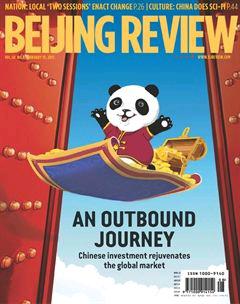World Factory to World Investor
By+Zhou+Xiaoyan


Dubbed “the world factory,” China has a long history of being a paradise for global investors, with an abundant and cheap labor force, vast land and a wide range of preferential policies. However, that tradition changed dramatically in recent years, as the capital inflow to the country substantially slowed and capital outflow grew rapidly. The country ascended to join the worlds net capital exporters for the first time, with capital output outnumbering capital inflows last year.
Chinese investors channeled capital into 6,128 overseas firms in 156 countries in 2014, with outbound direct investment (ODI) in nonfinancial sectors reaching $102.89 billion, up 14.1 percent from a year earlier, according to the Ministry of Commerce (MOFCOM).
In sharp contrast, foreign direct investment to China grew much slower at 1.7 percent, totaling $119.56 billion in 2014. It was the first time two-way nominal capital flows have been near a balance, according to the MOFCOM.
“If Chinese firms investment through thirdparty financing is included, the total ODI volume would equal about $140 billion, which means China is already a net outbound investor,” said Shen Danyang, spokesman of the MOFCOM.
According to the MOFCOM, mergers and acquisitions were more diversified in investment projects and fields in 2014. Popular sectors, like the energy and mining sectors, continued to earn more investment, while active acquisitions pushed forward in the manufacturing sector and the agricultural sector.
Meanwhile, a better industrial investment structure is taking shape, with leasing and commercial service, mining and retail, and wholesale business as the top three key overseas investment sectors, said Shen.
Xing Houyuan, Vice President of the Chinese Academy of International Trade and Economic Cooperation (CAITEC), told Beijing Review that a surging ODI from China is a result of foreign countries thirst for investment and Chinese companies growing ambition for more development beyond the border amid an over- heated domestic economy.
“From the demand side, the world needs Chinese capital more urgently than ever. The infrastructure construction and high-end manufacturing in developed countries need Chinese investment, while developing countries, which are in a key period of their industrialization and urbanization, also need Chinas capital, technologies, equipment and expertise in infrastructure construction,” Xing specified.
“From the supply side, after 35 years of accumulation in capital, production capacity and experience in construction, China can meet global demand. Chinas industrial upgrade also requires the nation to transfer part of its advantageous production capacity to other countries,” she said.
Marching forward
According to the MOFCOM, outbound investment from China grew over 40 times over the past 12 years.
“Its a result of the governments strategy to go global as well as Chinese companies continuous efforts,” said Long Guoqiang, a senior research fellow with the Development Research Center of the State Council.
The fact that China has become a net capital exporter signals the Chinese economy has been infused into the global economy and both the competitiveness and internationalization of Chinese companies have greatly improved, Long said.
Zhang Yongjun, a research fellow with the China Center for International Economic Exchanges, said its a rare phenomenon for a country to become a net capital exporter when its still a developing country, breaking the previous trend that only developed countries may join the club of net outbound investors.
“The main reasons for the surging ODI are Chinas economic upgrade, continuous trade surplus, abundant foreign exchange reserves as well as the countrys advantages in several industries,” Zhang said.
Deng Yujun, an economics professor with the South China Normal University based in Guangdong Province, said capital outflow from China will greatly facilitate the internationalization of the Chinese currency, the yuan.
“Among the total outbound investment from China, the majority is yuan-denominated, making the currency one of the most popular clearance and reserve currencies in the world,”Deng said.
With $4 trillion in foreign exchange reserves and continuous supportive policies such as the Silk Road Economic Belt and 21st Century Maritime Silk Road initiatives, the potential for a much larger flow of outbound investment from China is enormous.
To better integrate the regional economy, China proposed the Belt and Road initiatives in 2013. Last November, Chinese President Xi Jinping announced that China would contribute$40 billion to set up a Silk Road infrastructure fund to break the bottleneck in Asian connectivity by building a financing platform. The Chinaled Asian Infrastructure Investment Bank, which was established last October, will be dedicated to funding infrastructure projects in Asia.
CAITECs Vice President Xing said the two initiatives will further increase outbound investment from China. China has accumulated a lot of experience and expertise in infrastructure construction, which will greatly contribute to countries involved in the two initiatives, she said.
“China is a big country but not yet a strong one. China doesnt want to be strong alone. It wants to share its prosperity with other countries to achieve mutual benefits. Therefore, this is not the government-pushed ‘Marshall Planas some have speculated,” Xing said. Officially known as the European Recovery Program, the Marshall Plan invested $17 billion in the rebuilding and bolstering of European economies after World War II.
Xing said the Marshall Plan aimed at boosting U.S. influence in Europe, while the two initiatives are both about planning, building and sharing fruits of development of countries and regions along the proposed routes. “China will definitely respect the will of countries along the proposed routes and give full consideration to their needs so as to achieve win-win and multiwin results.”
Roadblocks
Despite remarkable progress in overseas investment, China still has a long way to go before becoming a more sophisticated capital exporter like the United States and Japan.
According to data from the MOFCOM, accumulated ODI from China stood at $646.3 billion as of the end of 2014.
Jiang Zengwei, Chairman of China Council for the Promotion of International Trade, said the accumulated ODI from China is a small number compared to those top global investors.
“Its about one tenth of the accumulated ODI from the United States, half of the ODI from Japan and one third from Germany,” Zeng said.
“But I think as China becomes a more international company, Chinas ODI still has huge development room,” Jiang said.
With that being said, Jiang said Chinese companies overseas foray is not without obstacles.
Chinas telecom operators Huawei or ZTE were blocked from the United States over security concerns in 2012. Last year, the Mexican Government cancelled a $3.7-billion highspeed train contract won by a group headed by China Railway Construction. In addition, Chinas top smartphone maker Xiaomi was mired in lawsuits on the ground of intellectual property infringement in India.
“They will face many challenges and uncertainties when expanding overseas markets, including accelerating trade protectionism worldwide, an ever-changing international market, a lack of understanding toward the political and economic environment in investment destinations, poor access to financing channels and the shortage of a talent pool thats familiar with international business operations,” Jiang said.
Wang Huiyao, Director General of the Center for China and Globalization, a non-profit think tank based in Beijing that conducts research on many global issues, agreed.
“Lack of trust with local stakeholders, fierce competition from local and Chinese counterparts and ignorance of the local regulatory and cultural environment have caused trouble in overseas investments and operations,” Wang said. “It requires careful homework and cooperation with government, professional thirdparty agencies and qualified international talent to be a competent and responsible buyer.”
Xing summarized the risks facing Chinese companies overseas expansion as follows.
“First, there are risks caused by uncontrollable factors, such as natural disaster, religious conflict and war. Second, some risks occur because Chinese companies fail to adapt to local environment, have flawed internal control or have poor abilities to integrate local resources. Finally, there are trade protectionism laws specifically targeting Chinese companies or citizens, such as the deadly riots targeting Chinese people in Viet Nam last May and untenable allegations from the United States over national security concerns targeting Chinese companies,” Xing said.
“Chinese companies can buy relevant insurance to reduce losses in case of the first type of risk. For the second type of risk, Chinese companies should improve their management standards and strengthen internal control in overseas markets. Industrial organizations can play their role in this respect, too, through methods like disciplining Chinese companies and preventing cutthroat competition among Chinese companies,” Xing suggested.
“As for trade protectionism, I dont think any company is powerful enough to solve it. Companies concerned should report that to the Chinese Government and the issue should be solved in government-level bilateral talks,” Xing said.

